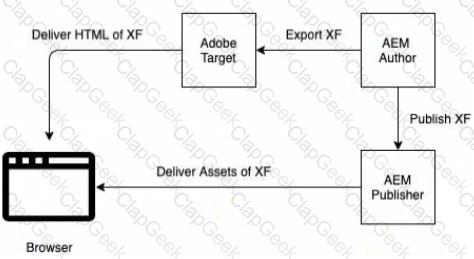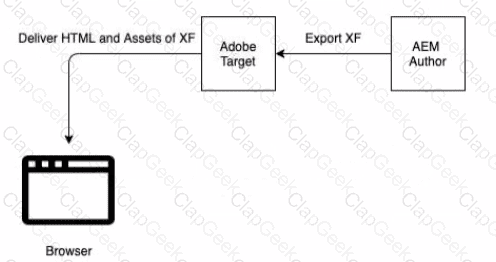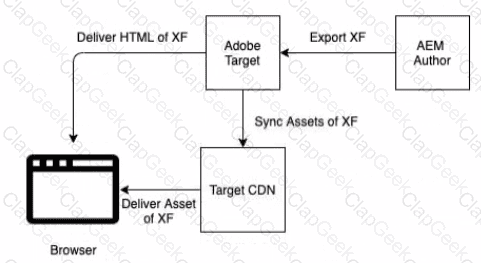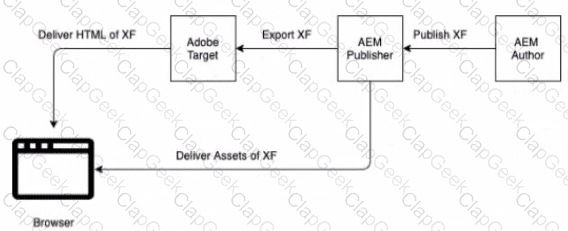On the release day, an AEM code deployment is done on AEM 6.5 on-prem. After the deployment was completed, the users were able to get into the Author instance with no issues. However, users are unable to access any of the sites on public domains. The users are seeing a "502 Bad Gateway" error.
What would be the potential cause of this issue?
A retail customer with an international presence and both in-store and online sales needs a new assets platform. The customer decides to use A£M assets. The customer's sites will continue to run on their proprietary CMS for websites.
The customer wants to be able to scale the platform for spikes in user traffic such as on local sales or online marketing campaigns. Under some circumstances, the customer also has a higher load of editors for a certain period of time.
Which architecture should an Architect use for this business case?
AEM Site users report that the web content pages render very slowly. An Architect notices that the CPU usages of the AEM Publish instances are spiking and reviews the following entry in the log:
[Frt Nov 27 23:11:00 2019] [I] [pid 16004 (tid 140134145820416)] Current cache hit ratio: 47.94 %
What should the Architect do to increase the dispatcher cache ratio and prevent the AEM Publish CPU usage spikes?
An AEM Sites implementation is migrating from on-premise to AEM as a Cloud Service. Previously, the application was deployed in a single package for both code and access policy nodes. After initial deployment and testing in the new infrastructure, it is reported that user permissions are not working as expected.
What change should the Architect make to address this issue?
A website hosted on AEM as a Cloud Service (AEMaaCS) uses a private key to decrypt data received from a secure web platform. The private key is stored as an encrypted OSGi configuration on the AEM publishers using the OOTB AEM Crypto Support bundle. The architect has received reports from developers stating that while the feature works on the AEMaaCS environments, they fail to decrypt the data on the local development environment.
What two actions would the architect take to resolve the issue? (Choose two.)
During development the AEM Publisher server keeps crashing randomly. The deployment included a new static FAQ component that was used in the websites Contact Us page. An Architect investigates to find the root cause for the random failures, and notices the following parameters:
• The server slows down when requests are sent to the Contact us page
• The number of requests to the page were very few
• Heap dump shows a large number of instances of the FAQ component
What is likely causing this issue?
After building an AEMaaCS website, it was found that non-cached secured static content will put too much load on the servers. How can this secured static content be cached without creating a security concern?
A news agency editor wants to publish news articles to an intermediate Publish (preview) instance for internal review before publishing the article to production Publish instance.
Which two steps should the Architect recommend? (Choose two.)
A renowned eCommerce company's flagship product page witnesses a dramatic surge in traffic during the holiday seasons. Over the past few sales events, users have highlighted slower load times and sporadic outages. Preliminary analysis suggests that the current setup might be straining under the increased traffic. The company has recently integrated a Content Delivery Network (CDN) and plans to fine-tune the dispatcher settings. The leadership emphasizes ensuring a seamless user experience for the forthcoming holiday season and wants to leverage the CDN and dispatcher optimally.
Given the situation described, which two approaches should be prioritized to bolster the performance and resilience of the product page during peak traffic? (Choose two.)
A media company surveys the end users of their AEM Sites website. The survey identifies that it is difficult to locate content on the site due to lack of relevancy and slow performance when navigating through the large volume of content.
To address both issues, the business team suggests integrating an innovative taxonomy product to the company s AEM implementation. The product is new on
the market and the development team has no experience with the technology.
Which two steps should an Architect recommend to evaluate this new feature? (Choose two.)
Content editors are uploading and editing thousands of PDFs daily, and notice a slow down of the AEM system over time while searching for assets in the DAM. The PDFs content does not need to be searchable. What would the AEM architect do to improve performance?
During an optimization session, a client using AEM 6.5 mentions that they face challenges with their AEM Author setup. The client has significant repository growth and can see an increased amount of TAR files in the segmentstore on disk. When editors are working, they see that workflows take up more time. The purging of workflows works as expected. Which two optimizations should an Architect suggest to took into and further investigate? (Choose two.)
A financial sector client is using AEM 6.5 on premise. The creative team needs to create the content for the various marketing campaigns that are scheduled. The client wants to use Experience Fragments (XF) to accelerate content creation for marketing purposes.
Which Data flow diagram should an Architect use to communicate requirements to the client network team?
A)

B)

C)

D)

A customer has a website with 10,000 pages and wants to improve performance. Which option should be used?
An AEM architect is planning to move the existing content from an AEM 6.5 instance to an AEM as a Cloud Service instance using the Content Transfer Tool. The architect is going to run the offline compaction on AEM 6.5 for migration purposes. What two actions would the architect take before starting the migration? (Choose two.)
On AEM 6.5, a new "update asset title workflow" is flooding the JCR with unnecessary information on each instance of the Workflow. In which two ways would an architect prevent the "update asset title workflow" instances from being recorded? (Choose two.)
A customer's DAM and Sites is growing exponentially while preparing for a go-live. The AEM architect has noticed that the online compaction on the author failed yesterday and finds this log entry:
INFO [pool-23-thread-1] com.adobe.granite.maintenance.impl.MaintenanceJobsManagerImpl
Name='RevisionCleanupTask', Status='ERROR',
Result='Revision GC: Stopped by user.',
Details='("created":1668218400006,"started":1668218400006,"finished":1668229200598,"duration":10800592}'
What step would the architect take to resolve this issue for the production environment with no downtime?
An Architect is performing infrastructure and capacity planning for Author servers for a customer using AEM 6.5. Which two factors would lead the Architect to pick a multi-author instance architecture setup? (Choose two.)
A client using AEM 6.5 on-premise is experiencing an unsustainable repository growth of 100Gb a day. After investigation, an Architect finds out that the DAM is causing this issue. Each image uploaded to the DAM triggers the creation of approximately 100 renditions, necessary by business to consume in different channels and systems. The client also complains about stale content reported by site visitors happening randomly in pages where article-related components are present.
How should the Architect address these issues?
A customer is migrating from their On-Premises AEM 6.4 instances to AEM as a Cloud Service. Next to the required code refactoring, a content migration of approximately 100,000 pages needs to be performed. The customer wants the content freeze period to be limited so that editors can continue to do content actions as long as possible.
Which two recommendations should the Architect make for the migration of the content pages? (Choose two.)
An AEMaaCS customer wants to have a sub section in site to accept data from an end user, which may be text as well as documents. The site is expected to have high data input which would need moderation and masking before making it live for public access. Due to a legal content policy, the data collected through the site cannot be shared outside the organization. What would an architect recommend?
A website hosted in AEM 6.5 is re-structured with new information architecture for site hierarchy including a new content root. The go-live release is planned to be divided into a few phases on a country basis. Those countries not involved will continue to be served with the existing content resources.
Which configuration would be implemented for the website to continue serving without impacting existing website journeys?
A fashion retail company is planning to enhance the online shopping experience by integrating Adobe Experience Manager (AEM) with a third-party commerce platform using the Commerce Integration Framework (CIF). What are the purpose and benefits of using CIF in this integration?


